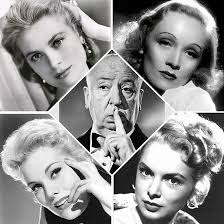Hitchcock
https://create.piktochart.com/output/27564784-new-piktochart
Hitchcock was seen as an auteur with a number of signalure themes and pre-occupations in his films. These included…
➤The innocent man falsely accused, pursued or persecuted - the ‘wrong man’ motif
➤A hero burdened with guilt or charged with proving his innocence
➤An emphasis on voyeurism - the characters watching and being watched/spied on.
➤An ‘ice cool’ blond female who the hero must pursue or tame
➤Recurrent motifs: Stairs, doorways, falling from high places, ‘the mcguffin’, overbearing mothers, the perfect murder, and charming villains.
➤By the late 1950s the Studio system was both at the height of its development and on the verge of changes which would sweep it away by the mid 1960s.
➤After years of success in film and TV Hitchcock was a housed name and was one of a small number of directors who had largely gained independence from Studio interference. By the late 1950s Hitchcock had made films for most of the major studios - usually on his terms. Recent hits had included Rear Window
➤Hitchcock worked with a close knit team of regulars he trusted to fulfil his vision of ‘pure cinema’. They included Robert Burks (DP), George Tomasini (Editor), Henry Bumstead (Art Director), Bernard Hermann (Music), Saul Bass (Titles) and Edith Head (Costume). He worked repeatedly with certain stars - including Cary Grant and James Stewart. Hitchcock could hire any of the leading ladies of the day.
Hitchcock was seen as an auteur with a number of signalure themes and pre-occupations in his films. These included…
➤The innocent man falsely accused, pursued or persecuted - the ‘wrong man’ motif
➤A hero burdened with guilt or charged with proving his innocence
➤An emphasis on voyeurism - the characters watching and being watched/spied on.
➤An ‘ice cool’ blond female who the hero must pursue or tame
➤Recurrent motifs: Stairs, doorways, falling from high places, ‘the mcguffin’, overbearing mothers, the perfect murder, and charming villains.
➤By the late 1950s the Studio system was both at the height of its development and on the verge of changes which would sweep it away by the mid 1960s.
➤After years of success in film and TV Hitchcock was a housed name and was one of a small number of directors who had largely gained independence from Studio interference. By the late 1950s Hitchcock had made films for most of the major studios - usually on his terms. Recent hits had included Rear Window
➤Hitchcock worked with a close knit team of regulars he trusted to fulfil his vision of ‘pure cinema’. They included Robert Burks (DP), George Tomasini (Editor), Henry Bumstead (Art Director), Bernard Hermann (Music), Saul Bass (Titles) and Edith Head (Costume). He worked repeatedly with certain stars - including Cary Grant and James Stewart. Hitchcock could hire any of the leading ladies of the day.
➤The
Hitchcock ‘signature’ was his brief cameo in all his films.
From Mr Cooper


Comments
Post a Comment